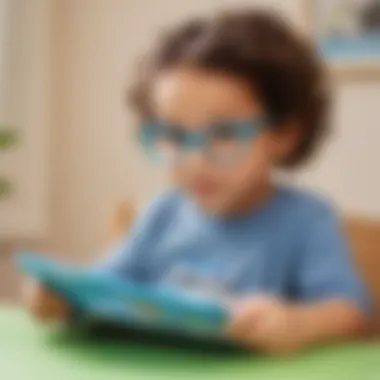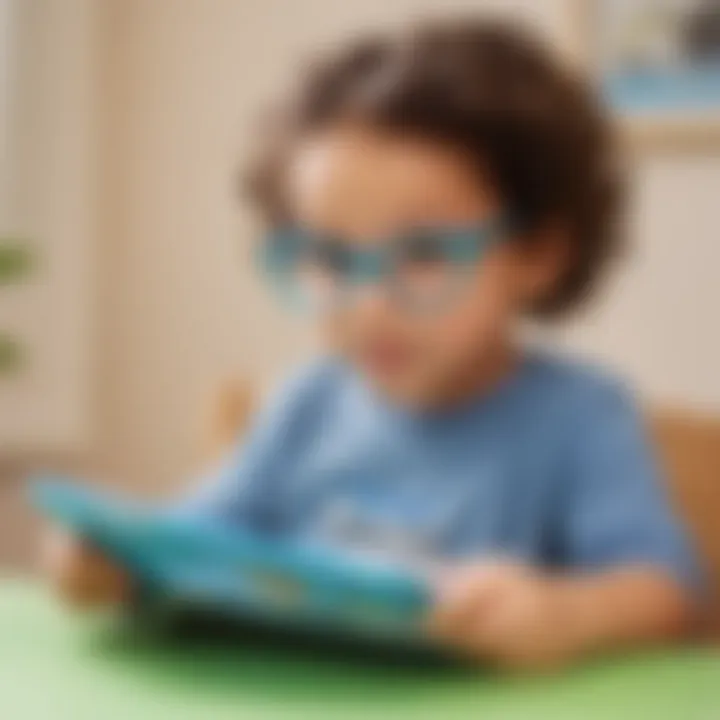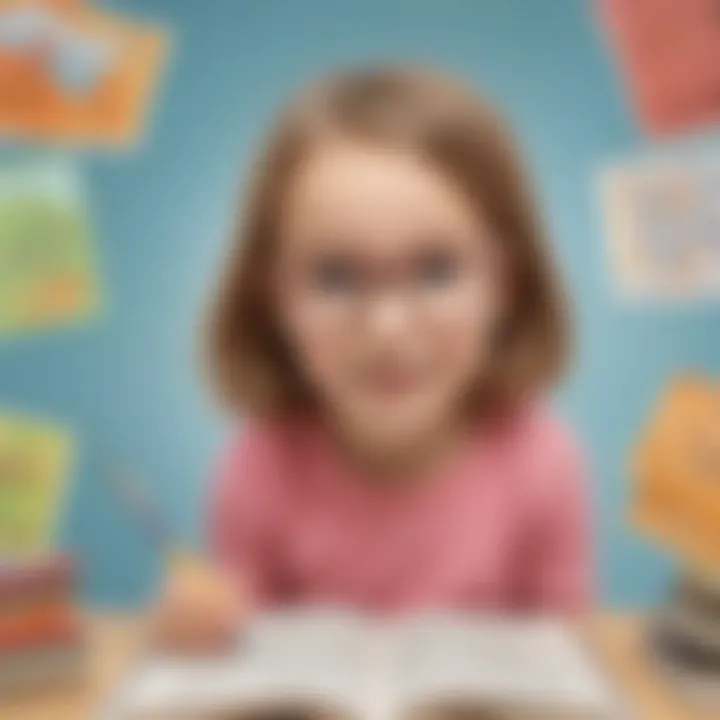The Impact of Sight Word Learning Apps on Literacy Development


Intro
In today’s educational landscape, the role of technology in learning is more prominent than ever. Sight word learning apps are a fascinating area of focus as they align with this trend. These applications provide innovative methods to engage elementary school children in literacy development. They offer interactive activities designed to improve recognition and recall of common sight words. Moreover, the digital format can tailor learning experiences to suit various developmental needs, making them beneficial tools in the literacy toolkit.
The transition from traditional teaching methods to incorporating apps is significant. Many educators and parents find themselves evaluating the effectiveness of both approaches. This article dives deep into the positive impacts of sight word learning apps, investigating their contribution to literacy skills among young learners.
This exploration is structured into key sections that address the essential facets of sight word learning apps. By doing so, it will assist parents and educators in making informed choices regarding literacy tools. Introduction to creative activities, engaging quizzes, and fact-based resources will be part of this discussion. Each element aims to inform and empower stakeholders in the literacy journey of children. With clear guidelines and insights, readers will gain a broader perspective on implementing these apps effectively.
Foreword to Sight Word Learning
Sight word learning plays a critical role in early literacy development. It contributes significantly to children's reading fluency and comprehension. This introduction sets the stage for understanding how sight words function as a cornerstone in literacy education and why they are essential in today's digital learning environments.
Defining Sight Words
Sight words are commonly used words that children are encouraged to recognize without needing to sound them out. These words often include common articles, prepositions, and conjunctions. For example, words such as "the," "and," and "is" frequently appear in children's reading materials. Recognizing these words on sight allows young readers to develop the necessary rhythm and flow in their reading, which is key for comprehension.
Importance in Early Literacy
The importance of sight words in early literacy cannot be understated. Mastery of sight words lays a solid foundation for reading skills in children. It serves several critical functions:
- Fluency Development: By recognizing sight words effortlessly, children can focus on the meaning of sentences rather than decoding each word. This enhanced fluency leads to better understanding.
- Comprehension Boost: Knowing sight words enables children to grasp complex texts sooner. They spend less time on familiar words, allowing them to engage more deeply with content.
- Confidence Building: As children become proficient in recognizing sight words, they gain confidence in their reading abilities. This can encourage them to explore more complex literature, fostering a lifelong love for reading.
"Fluency with sight words allows young readers to unlock the joy of fluent reading, paving the way for overall academic success."
In summary, this section underscores the need for effective sight word learning strategies, which are further enhanced by modern technological tools. Understanding sight words is the first step in developing comprehensive literacy skills that children will use throughout their academic journeys.
Overview of Learning Apps
The digital age has revolutionized the way education is delivered, making learning more accessible and interactive. Sight word learning apps are part of this evolution, offering various benefits that enhance literacy development in young learners. Understanding these applications is crucial for parents and educators wishing to optimize literacy outcomes for children. This section explores the importance of learning apps, focusing on their evolution and types available.
The Evolution of Educational Technology
Educational technology has undergone significant transformations in recent decades. Initially, learning relied on traditional methods such as textbooks and worksheets. However, with the advent of the internet and mobile devices, the landscape began to shift.
- Digital tools emerged, integrating multimedia resources.
- The rise of smartphones and tablets allowed for on-the-go learning, making educational content widely available.
- Recent advancements have introduced sophisticated applications that adapt to individual learning styles.
This evolution is essential as it aligns with the needs of contemporary learners who are accustomed to technology. As sight word apps continue to develop, they provide more interactive and engaging experiences for children, promoting better retention and understanding of literacy skills.
Types of Learning Apps
Sight word learning apps come in various formats, each serving specific purposes. Recognizing the different types can help parents and educators select the most effective tools for their children.
- Flashcard Apps: These apps offer simple interfaces where children can view words on flashcards, aiding memorization through repetition. Popular examples include Sight Words Flash Cards and Teach Your Monster to Read.
- Game-Based Learning: Apps like Endless Alphabet utilize gamification to make learning fun and engaging. As children play games, they naturally learn new sight words in context.
- Progress Tracking Applications: Some apps, such as Sight Words by Word and iPractice Math, enable parents and teachers to track a child's progress in real-time, allowing for targeted support.
- Interactive Storybooks: Applications that incorporate sight words into storytelling, such as Reading Rainbow and Starfall, help children read in a context, enhancing comprehension.
Benefits of Sight Word Learning Apps


The discussion around the benefits of sight word learning apps is crucial for understanding their role in literacy development. Sight word recognition is a foundational skill in reading. These apps offer unique features that address the diverse needs of young learners. They have become tools that provide more than mere flashcards; their interactive nature engages students in unique learning experiences.
Interactive Features
One of the most significant advantages of sight word learning apps is their interactive features. Unlike traditional paper-based methods, apps incorporate elements like touch, sound, and animation. This interaction can enhance memory retention. For instance, when children touch a word and hear its pronunciation, it reinforces their connection to that word.
Additionally, many apps include games and challenges that encourage repetition in a fun context. This repeated exposure to sight words in various formats helps children solidify their understanding. Basically, interaction promotes active learning, which is more effective than passive reading.
Personalization and Adaptability
Personalization is another key benefit of sight word learning apps. Each child learns at their own pace. Some may grasp concepts quickly, while others require more time. These apps allow for adaptive learning experiences tailored to individual progress. For example, an app might adjust its difficulty based on the child's performance, presenting new words when they are ready. This adaptive learning also helps identify the child's strengths and weaknesses.
Moreover, users can choose from different modes of learning based on their preferences. Some children may prefer visual aids, while others benefit from auditory input. This flexibility accommodates diverse learning styles, making it easier for parents and educators to support literacy development.
Engagement and Motivation
Engagement is a critical factor in the learning process. Sight word learning apps often utilize bright colors and captivating graphics to attract young learners. Moreover, many programs include rewards, such as stars or badges, to motivate students. This gamification of learning makes literacy a more engaging experience.
When children see positive reinforcement for their efforts, they feel motivated to continue practicing. This motivation is fundamental for maintaining interest in reading during a pivotal time in their developmental journey.
"A child’s willingness to explore reading can be significantly enhanced through interactive and rewarding experiences provided by learning apps."
Ultimately, the benefits of sight word learning apps extend beyond simple recognition of words. They promote a dynamic and adaptable learning environment, effectively supporting literacy development in elementary school children. The impact of these elements plays a vital role in shaping young learners' paths toward reading proficiency.
Challenges of Digital Learning Tools
As technology becomes ingrained in learning environments, it is essential to understand the challenges that accompany digital tools, including sight word learning apps. These challenges potentially influence the effectiveness and overall acceptance of such applications in literacy development. Addressing these issues allows parents and educators to make informed decisions about app implementation while safeguarding the educational experience for children.
Screen Time Considerations
Screen time is a significant concern among parents and educators. While sight word apps can enhance learning, excessive screen time can have negative effects on a child's physical and mental health. Many authorities recommend limiting screen exposure, particularly for younger children. It is crucial to set boundaries to ensure that apps complement rather than replace other activities.
Research indicates that prolonged screen time can lead to issues like eye strain, poor posture, and decreased physical activity. Therefore, balancing app use with offline activities, such as reading physical books or engaging in outdoor play, fosters a healthier lifestyle while supporting literacy objectives.
Potential for Distraction
Digital platforms often present distractions that can impede learning. Notifications and other app features may divert a child's attention from their reading tasks. In sight word learning, focus is paramount. A child distracted by unrelated games or pop-ups may struggle to absorb crucial material. Strategies to minimize these distractions are essential.
Educators and parents should look for apps that offer a streamlined experience. Features that reduce notifications and enhance content focus can significantly improve a child's ability to engage with sight words. Additionally, creating a distraction-free environment during app usage helps heighten attention and learning outcomes.
Accessibility Issues
Accessibility remains a vital aspect of any learning tool. Not all children have equal access to technology or high-speed internet, which can create disparities in learning opportunities. Also, physical disabilities and sensory impairments can limit a child's interaction with apps, making it critical for developers to consider inclusive design principles.
When evaluating sight word learning apps, it is essential to review their accessibility features. This includes screen reader compatibility and options for adjusting text size and background color. Promoting equality in educational technology ensures that every child, regardless of their circumstances, can benefit from literacy development initiatives.
"Accessibility in education is crucial for ensuring that all children, regardless of their backgrounds, have equal opportunities to learn and succeed."


Through understanding these challenges, parents and educators can adopt a more nuanced approach when integrating sight word learning apps into literacy practices. Being mindful of screen time, minimizing distractions, and striving for accessibility promotes a more effective learning environment.
Selecting the Right Sight Word Learning App
Choosing the right sight word learning app is crucial for maximizing literacy development in young learners. With the vast options available, selecting an app that effectively supports a child’s learning journey can feel overwhelming. A well-chosen app not only engages children but also complements their unique learning styles. Therefore, it is essential to carefully consider several factors before settling on a specific application.
Evaluating Educational Value
When assessing a sight word learning app, educational value is paramount. This refers to the app's ability to teach sight words in a way that builds comprehension and retention. Look for apps that incorporate evidence-based educational practices. These may include systematic phonics approaches or interactive elements that allow children to practice reading in context. Some apps also provide progress tracking, offering insights into a child's development. This feature can be especially beneficial for parents and educators to tailor further instruction.
User Interface and Experience
An app’s user interface and overall experience can significantly impact a child's willingness to engage. Look for designs that are intuitive and age-appropriate. Bright colors and simple navigation can help hold the interest of young users. Additionally, the app should promote interaction without overwhelming distractions. It is vital to ensure that children can focus on learning while being guided by familiar and simple processes. An effective app invites repetition, which is essential in sight word acquisition.
User Reviews and Recommendations
Before choosing a sight word learning app, it's wise to consult user reviews and recommendations. Insights from other parents and educators can shed light on the app's effectiveness. Look for comments that discuss not only the educational impact but also the ease of use. Pausing to consider ratings and testimonials gives a clearer picture of how the app functions in real-world settings. Recommendations from reputable sources can also provide additional assurance that the app is a sound choice.
"User feedback highlights trends in effectiveness that can guide your choices for educational resources."
When selecting an app, balancing these elements—educational value, user interface, and feedback from other users—ensures that the sight word learning tool chosen not only enhances literacy but also makes the learning process enjoyable for children.
The Role of Educators and Parents
Educators and parents play a crucial role in the literacy development of children, especially when integrating technology into learning. Sight word learning apps have gained popularity due to their interactive and engaging features. However, the effectiveness of these tools greatly depends on how educators and parents use them.
The involvement of adults can help guide children in navigating these apps. They can provide support and make learning a collaborative effort. This approach can enhance comprehension and retention. Effective use of these apps can lead to significant improvements in a child’s reading abilities.
Supporting Learning with Technology
Integrating technology in learning is not just about having access to devices. It involves understanding how to effectively support children in using apps to maximize their benefits. Parents and teachers can introduce sight word learning apps as supplementary resources, rather than replacements for traditional education methods.
Some strategies include:
- Setting clear objectives: Together, parents and teachers can identify specific learning goals for children. This allows them to choose suitable apps that align with those objectives.
- Regular monitoring: Observing how children use these apps can help ensure they are engaging with content appropriately. This also enables adults to offer assistance when needed.
- Encouragement and praise: Positive reinforcement can motivate children to continue using the learning apps.
The combination of support from educators and parents can create an effective learning environment. This sets a solid foundation for literacy development in young learners.
Balancing Digital and Traditional Methods
While sight word learning apps have their advantages, maintaining a balance between digital and traditional learning methods is essential. Overreliance on technology may lead to issues, such as decreased attention spans and reduced interpersonal skills.
To foster a well-rounded literacy experience:
- Incorporate printed materials: Parents and educators should provide physical books alongside app usage. This helps children gain exposure to different formats and fosters a broader understanding of literacy.
- Engage in discussions: Encouraging children to talk about what they read—whether from an app or a book—improves comprehension. Adults can role-play characters or quiz children after reading sessions to deepen understanding.
- Limit screen time: Setting boundaries on how much time children spend on learning apps is vital. Experts recommend balancing screen time with physical play and hands-on learning activities.


By promoting a diverse learning ecosystem, educators and parents can enhance children's literacy skills. This balance not only maximizes the benefits of sight word learning apps but also prepares children for future educational challenges.
"A child’s ability to read and comprehend is influenced by the quality of interaction they have with adults, whether through technology or traditional means."
Through effective collaboration, educators and parents can create an enriching literacy environment that leverages the strengths of both digital and conventional learning to support children's growth.
Future Trends in Sight Word Learning Apps
As technology rapidly changes, understanding the future trends in sight word learning apps becomes vital. These apps not only support literacy but also adapt to the changing educational landscape. They will reflect innovative teaching methods and cater to the diverse needs of learners. The trends discussed here will provide insight into how developments in technology can enhance literacy development.
Incorporating Artificial Intelligence
Artificial Intelligence (AI) is emerging as a revolutionary component in education. Incorporating AI into sight word learning apps can personalize learning experiences. For example, these apps can adapt to a child’s learning pace and style, providing tailored exercises and feedback. This responsiveness allows children to engage with the material at a level suitable for them.
AI-driven apps can assess a learner’s strengths and weaknesses in real-time. They can then adjust the complexity of the words or phrases presented. This dynamic approach helps maintain user interest and optimizes learning outcomes. Moreover, an AI system can analyze progress over time, offering valuable insights for educators and parents.
The advancements in natural language processing also mean that these apps can better understand user input, making them more interactive. Children can practice speaking sight words aloud, and the app can evaluate their pronunciation. This interactive feature adds an important auditory element to the visual learning of sight words.
Enhancing Collaborative Learning Experiences
Collaboration is essential in learning, and enhancing collaborative learning experiences with sight word learning apps offers numerous benefits. Through features like shared activities or group challenges, children can learn from each other. This peer interaction not only boosts engagement but also fosters essential social skills.
Apps can enable features that allow parents or educators to set group learning tasks. For instance, they can create word games where children work in teams to complete challenges. This not only promotes learning but also makes it enjoyable. Collaborative tasks can include activities like spelling bees or group quizzes, where kids cheer each other on.
Furthermore, incorporating social features allows children to share achievements with their classmates or family. Badges or rewards can be displayed in a shared space, motivating them to continue learning together. This sense of community builds confidence and accountability among young learners.
Epilogue on Future Trends
In summary, the landscape of sight word learning apps is evolving. By incorporating artificial intelligence, these tools are becoming more personalized and adaptable. Additionally, enhancing collaborative learning experiences fosters an engaging, social environment for literacy development. As these trends continue to develop, the efficacy of sight word learning apps will likely increase, helping children build essential literacy skills in innovative ways.
"The integration of technology in education, particularly sight word learning apps, is changing how literacy is taught and learned."
Through careful adoption of these trends, educators and parents can ensure a bright future for literacy development.
The End
The conclusion of this article serves as a crucial touchstone for understanding the role of sight word learning apps in literacy development. As we summarize the significant points covered, it is essential to reflect on the potential these tools hold in transforming how children engage with reading.
Summary of Key Insights
Sight word learning apps stand as an innovative bridge between traditional literacy skills and the demands of modern learning environments. The key insights from this discussion can be outlined as follows:
- Enhancement of Engagement: Apps often incorporate gamified elements that make the learning process enjoyable for children.
- Personalized Learning: Many apps adapt to individual learning speeds and styles, allowing students to progress at their own pace.
- Increased Accessibility: Digital tools can reach a broader audience, providing resources to those who may lack access to traditional literacy support.
- Data-Driven Insights: Educators and parents can track progress through analytics, ensuring that interventions are timely and effective.
These attributes position sight word apps as valuable instruments in the literacy development toolkit. Thus, they are not merely supplementary but essential for fostering reading fluency among young learners.
Implications for Future Literacy Practices
As we consider the implications for future literacy practices, it becomes clear how sight word learning apps can persist in shaping educational strategies. These applications will very likely become integral to literacy instruction, influencing methods in several ways:
- Integration with Curriculum: Educators may start to embed these apps into standard literacy curricula, marrying digital with traditional approaches.
- Focus on Lifelong Learning: By instilling early reading habits through technology, children might develop a more profound and enduring relationship with reading.
- Collaboration and Sharing: Future developments in these apps could enhance collaborative learning experiences among peers, teachers, and families.
- Continuous Improvement: As technology evolves, so too will app capabilities, which means ongoing enhancements in educational content will emerge, leading to improved literacy outcomes.
Ultimately, the use of sight word learning apps signals a shift in literacy education. This evolution demandsn that educators and parents stay informed and adaptable to harness the benefits these digital tools offer effectively. Such strategies can pave the way for successful literacy development and ensure children become proficient, enthusiastic readers.







